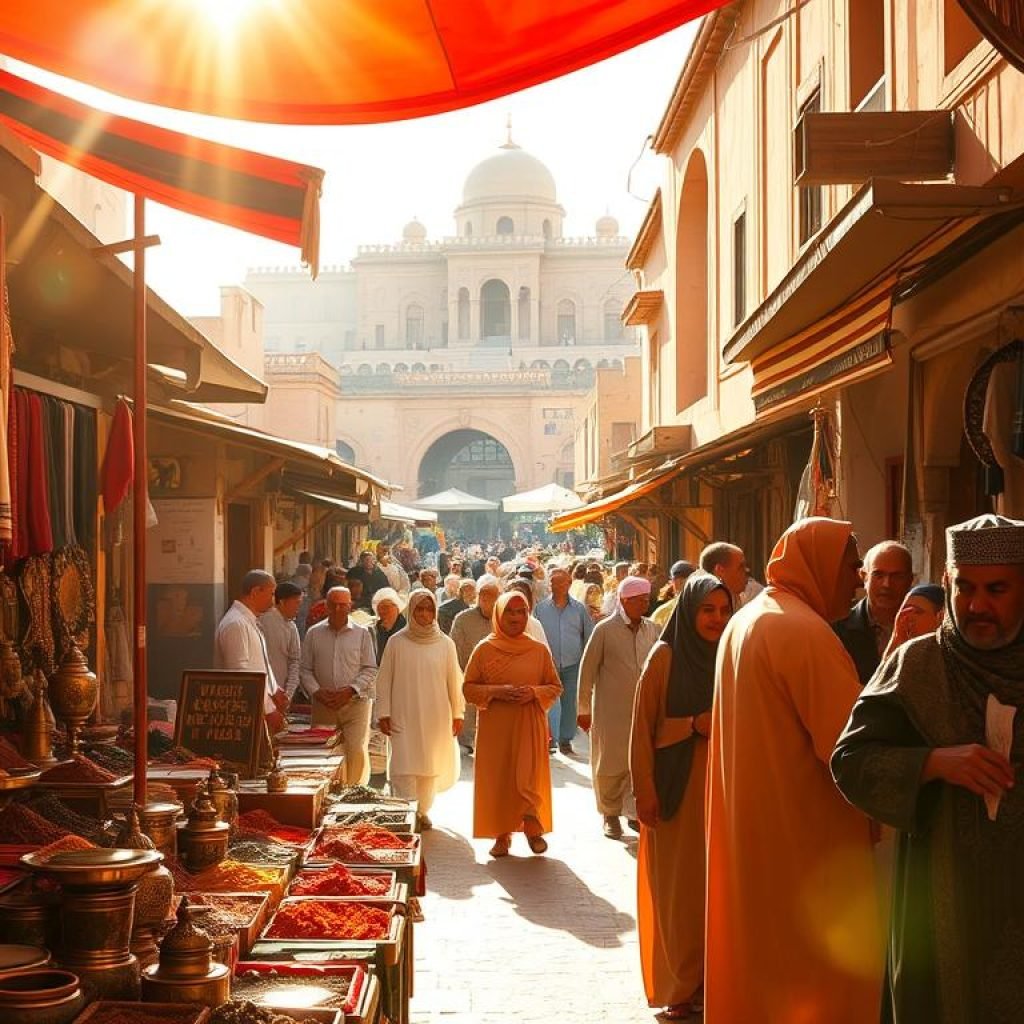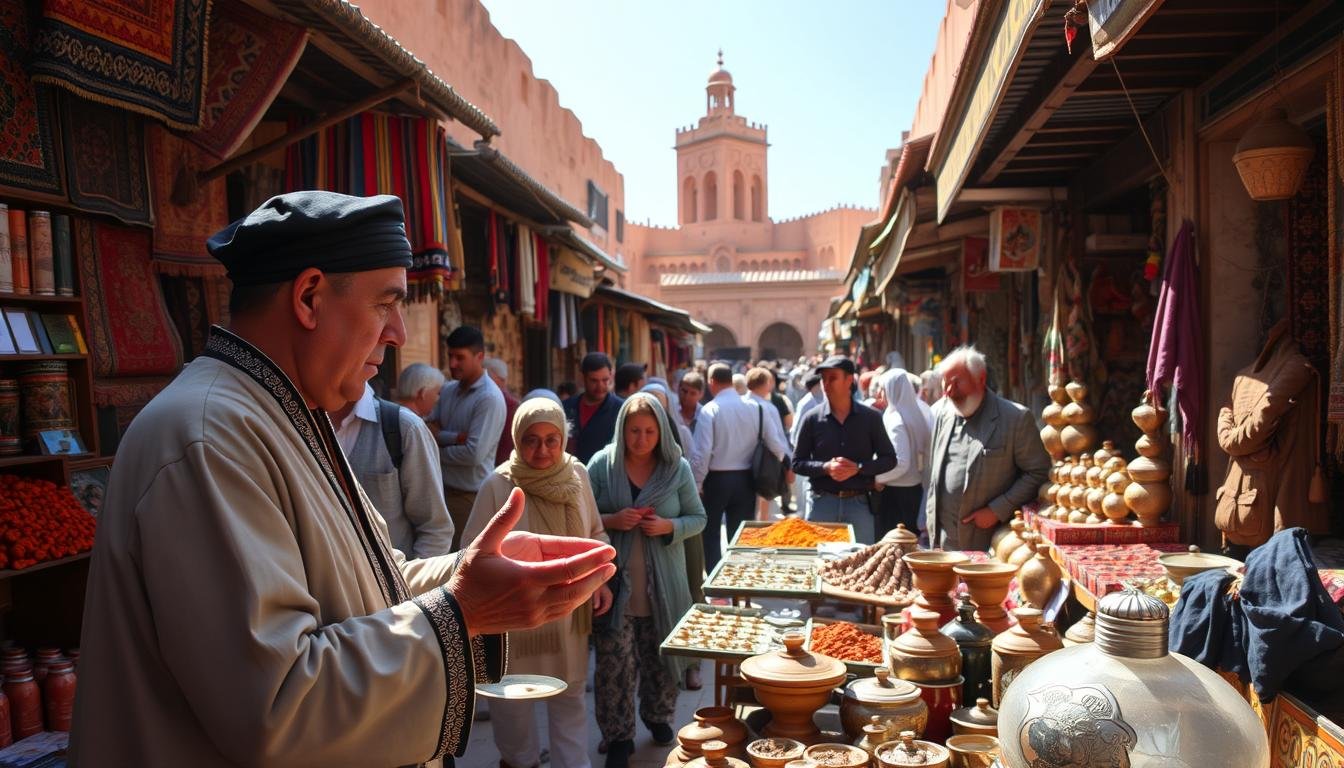Stepping into the bustling souks of Morocco is like entering a vibrant world of colors, scents, and sounds. The markets are alive with energy, offering everything from handcrafted treasures to unique souvenirs. But here’s the secret: the price you see isn’t always the one you pay. Haggling is not just a practice—it’s an art form deeply rooted in Moroccan culture.
Whether you’re eyeing a beautifully carved wooden box or a colorful rug, understanding the dynamics of a deal can transform your shopping experience. Vendors often start with higher prices, expecting you to negotiate. This back-and-forth isn’t just about saving money—it’s about connecting with the seller and respecting the tradition.
One of the most effective strategies is knowing when to walk away. Sometimes, showing disinterest can lead to a better offer. Remember, haggling is a dance, and both parties should leave feeling satisfied. As you dive into this guide, you’ll learn how to navigate this cultural practice with confidence and respect.
Key Takeaways
- Haggling is a cultural norm and expected in Moroccan markets.
- Starting prices are often higher, so negotiation is key.
- Knowing when to walk away can lead to better deals.
- Respect and friendliness go a long way in successful haggling.
- Cash transactions are preferred in most markets.
Exploring the Vibrant Moroccan Souks
The Moroccan souks are a sensory overload, where every corner tells a story of tradition and craftsmanship. These bustling hubs are more than just places to shop—they are cultural experiences that immerse you in the heart of Moroccan life.
Discovering Local Goods and Traditions
From handwoven rugs to intricate ceramics, the souks are filled with locally made treasures. Each item reflects the skill and artistry of Moroccan artisans. Traditional jewelry, leather goods, and textiles are just a few examples of what you can find.
These markets also showcase a blend of old and new. Alongside traditional crafts, you’ll find modern designs and high-end goods. This mix makes the souks a unique shopping destination for every visitor.
Understanding Medina and Market Layouts
The souks are typically located within the medinas, the historic city centers. Narrow alleys wind through the market, lined with stalls and shops. This layout creates an intimate and lively atmosphere.
Each section of the medina often specializes in specific goods. For example, you might find one area dedicated to spices and another to metalwork. This organization makes it easier to navigate and discover what you’re looking for.
Exploring these markets is not just about shopping—it’s about connecting with the culture. Engaging with local vendors and learning about their crafts adds depth to the experience. For more insights on navigating these interactions, check out this guide on bargaining in Moroccan souks.
Bargaining tips in Morocco
Navigating the lively markets of Morocco requires a blend of strategy and cultural awareness. Engaging with sellers is not just about getting a good deal—it’s about building a connection and respecting local traditions. Here’s how to approach the process with confidence and skill.

Starting the Haggling Process with Confidence
Begin by showing genuine interest in the item without appearing too eager. A friendly smile and polite conversation can set the tone. Sellers often start with higher prices, so don’t hesitate to counter with a lower offer. For example, starting at one-quarter of the initial price is a common tactic.
Remember, the first offer is just the beginning. The seller expects a back-and-forth, so stay calm and composed. This approach not only helps you secure a better deal but also shows respect for the negotiation process.
Setting Your Price and Knowing When to Walk Away
Before entering the negotiation, set a target price in your mind. This helps you stay focused and avoid overspending. If the seller’s offer doesn’t align with your budget, don’t be afraid to walk away. Often, this can prompt the seller to reconsider and offer a better deal.
Walking away is a powerful tool. It signals that you’re serious about your budget and willing to explore other options. Many sellers will chase you down to finalize the sale, giving you the upper hand.
Spotting Quality and Authenticity in Goods
Not all items in the market are created equal. Take your time to inspect the craftsmanship and materials. Authentic goods often have unique details and superior quality. For example, handwoven rugs may have intricate patterns, while mass-produced ones lack this level of artistry.
Ask the seller about the item’s origin and production process. This not only helps you assess its authenticity but also builds rapport with the seller. For more insights on identifying quality items, check out this guide on bargaining in Morocco.
Utilizing Cash and Small Denominations Effectively
Cash is king in Moroccan markets. Most sellers prefer cash transactions, and having smaller denominations can give you an edge. It allows you to negotiate more effectively and avoid revealing large amounts of money upfront.
Carrying small bills also makes it easier to finalize deals quickly. For instance, if the seller agrees to a price of 200 MAD, having exact change can streamline the process and leave both parties satisfied.
| Item | Initial Price | Negotiated Price |
|---|---|---|
| Handwoven Rug | 800 MAD | 400 MAD |
| Leather Bag | 600 MAD | 300 MAD |
| Ceramic Tagine | 200 MAD | 100 MAD |
Mastering the Art of Negotiation in Souks
The art of negotiation in Moroccan souks is a blend of strategy, respect, and cultural understanding. It’s not just about getting a lower price—it’s about building a connection and appreciating the tradition. Every interaction is an opportunity to learn something new and enhance your shopping experience.
Leveraging Cultural Cues and Communication
In the souks, communication goes beyond words. A friendly smile, relaxed demeanor, and light banter can set the tone for a successful negotiation. Sellers often use body language to gauge your interest, so maintaining eye contact shows confidence and respect.
Understanding local customs is key. For example, asking the price directly can signal inexperience. Instead, engage in conversation and show genuine interest in the item. This approach helps you achieve your goal while respecting the seller’s perspective.
Using Tactics like Starting Low and Meeting in the Middle
One effective tactic is to start with a lower price than what you’re willing to pay. This leaves room for compromise and shows you’re serious about the deal. Sellers often expect this and will counter with a more reasonable offer.
Meeting in the middle is a common way to finalize a deal. For instance, if the seller asks for 500 MAD and you offer 200 MAD, settling at 350 MAD is a fair compromise. This approach ensures both parties leave satisfied.
| Item | Initial Price | Negotiated Price |
|---|---|---|
| Handwoven Rug | 800 MAD | 400 MAD |
| Leather Bag | 600 MAD | 300 MAD |
| Ceramic Tagine | 200 MAD | 100 MAD |
By mastering these tactics, you can navigate the souks with confidence and enjoy a richer cultural experience. Remember, every negotiation is a chance to connect and learn something new about this vibrant way of life.
Timing, Tactics, and Cultural Etiquette
Timing is everything when exploring the vibrant markets of Morocco. Knowing when to shop and how to approach sellers can make a big difference. Early mornings are often the best time to visit, as vendors are more open to negotiation and the crowds are thinner.

Understanding the local culture is a key part of the experience. Sellers appreciate when you show respect and patience. This not only helps you get a better deal but also makes the interaction more enjoyable for both parties.
Finding the Best Times to Shop and Haggle
Early mornings are ideal for shopping in Moroccan markets. Vendors are fresh and more willing to negotiate. This is also the time when you can avoid the midday heat and crowds. Another great thing about early visits is that you get first pick of the goods.
Late afternoons can also be a good time to shop. Sellers are often eager to make a final sale before closing. However, make sure to stay polite and respectful, as this is a key part of the process.
Respectful Tactics and Cultural Awareness
When interacting with sellers, always start with a friendly greeting. This shows respect and sets a positive tone. A simple “Salam” (hello) can go a long way in building rapport.
Patience is another important thing to remember. Take your time to compare prices and inspect items. This not only helps you find the best deal but also shows the seller that you’re serious.
- Start with a lower offer but stay reasonable.
- Use small denominations of cash for easier transactions.
- Always thank the seller, even if you don’t make a purchase.
Understanding the local culture is essential. For example, avoid pointing out flaws in items too aggressively. Instead, use it as a subtle tactic to negotiate a better price. This approach ensures both parties feel satisfied.
By mastering these tactics, you can make the most of your shopping experience. Remember, it’s not just about the price—it’s about the connection and respect you build with the seller.
Conclusion
Exploring the vibrant markets of this North African gem offers more than just a chance to shop—it’s a cultural journey. From handcrafted goods to unique trinkets, every stall tells a story of tradition and skill. Mastering the art of negotiation is not just about securing a sale; it’s about connecting with the people and their heritage.
Understanding the market’s rhythm and respecting local customs can transform your experience. Whether you’re taking home a beautifully woven rug or a delicate tea set, every interaction is an opportunity to learn. Embrace the process with patience and a smile, and you’ll leave with more than just souvenirs—you’ll take home memories of a rich cultural exchange.
For more insights on making the most of your market visits, check out this guide on effective haggling. Remember, every step through the souks is a chance to discover something new about this fascinating culture.




Thanks for sharing the useful tips.